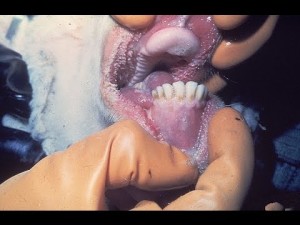Bluetongue is an insect-borne, non-contagious viral disease and is transmitted by insect vectors. The disease is caused by a virus belonging to the family Reoviridae.
Species affected
Primarily a disease of sheep but other species such as goats, cattle, buffaloes, camels, antelopes and deer can be infected besides, humans are unaffected.

Key signs
The disease is characterised by fever, widespread haemorrhages of the oral and nasal tissue, excessive salivation, and nasal discharge. In acute cases the lips and tongue become swollen and this swelling may extend below the lower jaw. Lameness, due to swelling of the cuticle above the hoofs and emaciation, due to reduced feed consumption because of painful inflamed mouths, may also be symptoms of this disease. The blue tongue that gives the disease its name occurs only in small number of cases. Convalescence of surviving sheep is slow. The high fever in sheep results in wool breaks, which adds to production losses.
Spread
Insects are the carriers for the transmission of virus between susceptible animals. The incidence and geographical distribution of bluetongue depends on seasonal conditions, the presence of insect vectors, and the availability of the susceptible species of animals. The insect carriers, biting midges, prefer warm, moist conditions and are in their greatest numbers and most active after rains.
Bluetongue virus does not survive outside the insect vectors or susceptible hosts. Animal carcasses and products such as meat and wool does not spread the disease. Survival of the virus within a location is dependent on whether the vector can overwinter in that area.
Control strategy
The strategy is to contain the outbreak and minimize trade impact by:
Using a combination of quarantine and movement controls to prevent spread
Treatments and husbandry procedures to control vectors, reduce transmission and protect susceptible animals
Tracing and surveillance to determine the extent of virus and vector distribution.
Zoning to define infected and disease-free areas.
There is no justification for stamping out but some animals may need to be destroyed for welfare reasons. It is not possible to eradicate the bluetongue vectors.
